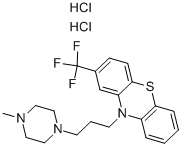440-17-5

Product Name:
Trifluoperazine dihydrochloride
Formula:
C21H26Cl2F3N3S
Synonyms:
10-[3-(4-Methylpiperazin-1-yl)propyl]-2-(trifluoromethyl)-10H-phenothiazine dihydrochloride;Trifluoperazine dihydrochloride
Inquiry
CHEMICAL AND PHYSICAL PROPERTIES
| Collision Cross Section | 188.5 Ų [M+H]+ [CCS Type: TW, Method: calibrated with polyalanine and drug standards] |
|---|
SAFETY INFORMATION
| Signal word | Danger |
|---|---|
| Pictogram(s) |
 Exclamation Mark Irritant GHS07  Health Hazard GHS08  Environment GHS09 |
| GHS Hazard Statements |
H302:Acute toxicity,oral H319:Serious eye damage/eye irritation H336:Specific target organ toxicity,single exposure; Narcotic effects H341:Germ cell mutagenicity H372:Specific target organ toxicity, repeated exposure H410:Hazardous to the aquatic environment, long-term hazard |
| Precautionary Statement Codes |
P201:Obtain special instructions before use. P273:Avoid release to the environment. P305+P351+P338:IF IN EYES: Rinse cautiously with water for several minutes. Remove contact lenses, if present and easy to do. Continuerinsing. P308+P313:IF exposed or concerned: Get medical advice/attention. |
COMPUTED DESCRIPTORS
| Molecular Weight | 480.4 g/mol |
|---|---|
| Hydrogen Bond Donor Count | 2 |
| Hydrogen Bond Acceptor Count | 7 |
| Rotatable Bond Count | 4 |
| Exact Mass | 479.1176589 g/mol |
| Monoisotopic Mass | 479.1176589 g/mol |
| Topological Polar Surface Area | 35 Ų |
| Heavy Atom Count | 30 |
| Formal Charge | 0 |
| Complexity | 510 |
| Isotope Atom Count | 0 |
| Defined Atom Stereocenter Count | 0 |
| Undefined Atom Stereocenter Count | 0 |
| Defined Bond Stereocenter Count | 0 |
| Undefined Bond Stereocenter Count | 0 |
| Covalently-Bonded Unit Count | 3 |
| Compound Is Canonicalized | Yes |
PRODUCT INTRODUCTION
description
Trifluoperazine Hydrochloride is the hydrochloride salt of trifluoperazine, a phenothiazine derivative and a dopamine, alpha-adrenergic, and anticholinergic antagonist with antipsychotic, anxiolytic, and antiemetic activities. Trifluoperazine blocks central dopamine receptors, which may prevent or mitigate delusions and hallucinations caused by an excess of dopamine; dopamine blockade in the chemoreceptor trigger zone (CTZ) may result in an antiemetic effect. This agent binds to central adrenergic receptors, which may result in anxiolytic effects. Trifluoperazine also functions as a calmodulin inhibitor, elevating cytosolic calcium.
